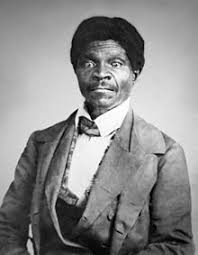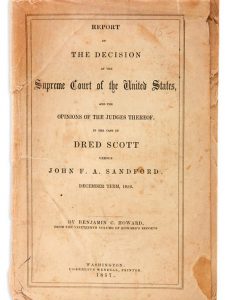Joseph Ritter
Dred Scott, born in Virginia in 1800, was a slave who would end up making a name for himself by suing for his own freedom. But why was his court case so important? Why is it still being discussed to this day? Who really was Dred Scott? From his early life and motivations for suing to his landmark case and the consequences it would hold, Dred Scott’s story should be told and remembered.
Around 1800, Dred Scott was born a slave to his master Peter Blow, whom he would travel with his first 32 years of life. In 1832, Blow passed away leaving Scott to be purchased by John Emerson, an Army surgeon who would become Scott’s new master. Emerson would take Scott to stay in Illinois then to Wisconsin, both of which being free territories. Scott would meet a slave woman in Wisconsin who he would end up marrying, and Emerson now owned her as well 1. Things would remain this way for a few years.
In 1843, Emerson passed away. His widow, who now owned Scott and his wife, hired the two to an Army captain. This prompted Scott to try and earn his freedom, an action that would eventually make huge waves in the world of American politics. His first trial came in 1847 where he lost because he could not prove that he and his wife were property of Emerson’s widow. However, he was granted a retrial that would take place in 1850. At this retrial, Scott and his wife were ruled free! Unfortunately, this decision would be overturned in 1852 after Emerson’s widow appealed the outcome. Scott would try and challenge this ruling in 1854 but failed. There was only one other option left. In 1857, Scott brought his case for freedom before the US Supreme Court. Unfortunately for Scott, the Supreme Court justices at the time were biased towards slavery with 7 of the 9 justices being appointed by pro-slavery presidents. In the end, it was ruled that Scott would remain a slave 1.

But the ruling did not stop there. The Supreme Court declared that not only was Scott a slave, but he was also not a citizen, stating “A free negro of the African race, whose ancestors were brought to this country and sold as slaves, is not a “citizen” within the meaning of the Constitution of the United States.” 2. It also declared the Missouri Compromise unconstitutional, stating that the government had no right to limit slaves in new territories as they were personal property. This ruling struck up a frenzy with those opposed to slavery, strengthening anti-slavery movements across the country, including the Republican party in 1854, who would go on to elect Abraham Lincoln to be President of the US. Some may argue that the Dred Scott decision was one of the key factors in the start of the Civil War 3.
The story of Dred Scott tells us a lot about the American past, and it is one I believe should continue to be examined for generations to come. So often throughout history does it take a truly horrible event for real change to happen, and Scott was, in many ways, a martyr for the anti-slavery cause. He passed away in 1858, a year after being freed by his old owner’s family, never truly seeing the ramifications of his actions, but living his last year on Earth a free man.

1.“Dred Scott’s Fight for Freedom.” PBS, Public Broadcasting Service, www.pbs.org/wgbh/aia/part4/4p2932.html.
2.“Scott v. Sandford.” LII / Legal Information Institute, Legal Information Institute, www.law.cornell.edu/supremecourt/text/60/393.
3.“Dred Scott Case Trials.” National Parks Service, U.S. Department of the Interior, www.nps.gov/resources/story.htm%3Fid%3D196.